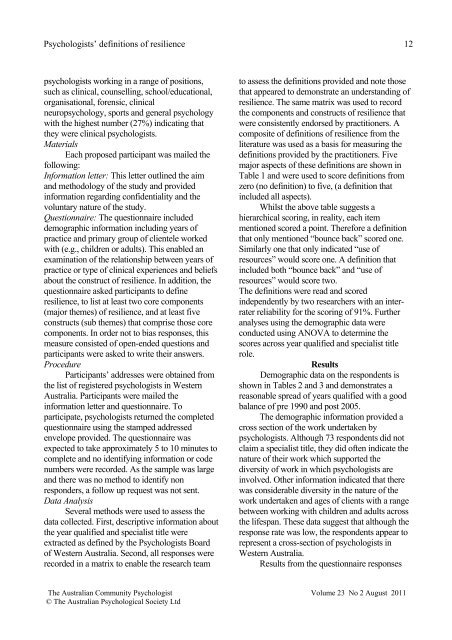The Australian Community Psychologist - APS Member Groups
The Australian Community Psychologist - APS Member Groups
The Australian Community Psychologist - APS Member Groups
You also want an ePaper? Increase the reach of your titles
YUMPU automatically turns print PDFs into web optimized ePapers that Google loves.
<strong>Psychologist</strong>s’ definitions of resilience<br />
12<br />
psychologists working in a range of positions,<br />
such as clinical, counselling, school/educational,<br />
organisational, forensic, clinical<br />
neuropsychology, sports and general psychology<br />
with the highest number (27%) indicating that<br />
they were clinical psychologists.<br />
Materials<br />
Each proposed participant was mailed the<br />
following:<br />
Information letter: This letter outlined the aim<br />
and methodology of the study and provided<br />
information regarding confidentiality and the<br />
voluntary nature of the study.<br />
Questionnaire: <strong>The</strong> questionnaire included<br />
demographic information including years of<br />
practice and primary group of clientele worked<br />
with (e.g., children or adults). This enabled an<br />
examination of the relationship between years of<br />
practice or type of clinical experiences and beliefs<br />
about the construct of resilience. In addition, the<br />
questionnaire asked participants to define<br />
resilience, to list at least two core components<br />
(major themes) of resilience, and at least five<br />
constructs (sub themes) that comprise those core<br />
components. In order not to bias responses, this<br />
measure consisted of open-ended questions and<br />
participants were asked to write their answers.<br />
Procedure<br />
Participants’ addresses were obtained from<br />
the list of registered psychologists in Western<br />
Australia. Participants were mailed the<br />
information letter and questionnaire. To<br />
participate, psychologists returned the completed<br />
questionnaire using the stamped addressed<br />
envelope provided. <strong>The</strong> questionnaire was<br />
expected to take approximately 5 to 10 minutes to<br />
complete and no identifying information or code<br />
numbers were recorded. As the sample was large<br />
and there was no method to identify non<br />
responders, a follow up request was not sent.<br />
Data Analysis<br />
Several methods were used to assess the<br />
data collected. First, descriptive information about<br />
the year qualified and specialist title were<br />
extracted as defined by the <strong>Psychologist</strong>s Board<br />
of Western Australia. Second, all responses were<br />
recorded in a matrix to enable the research team<br />
to assess the definitions provided and note those<br />
that appeared to demonstrate an understanding of<br />
resilience. <strong>The</strong> same matrix was used to record<br />
the components and constructs of resilience that<br />
were consistently endorsed by practitioners. A<br />
composite of definitions of resilience from the<br />
literature was used as a basis for measuring the<br />
definitions provided by the practitioners. Five<br />
major aspects of these definitions are shown in<br />
Table 1 and were used to score definitions from<br />
zero (no definition) to five, (a definition that<br />
included all aspects).<br />
Whilst the above table suggests a<br />
hierarchical scoring, in reality, each item<br />
mentioned scored a point. <strong>The</strong>refore a definition<br />
that only mentioned “bounce back” scored one.<br />
Similarly one that only indicated “use of<br />
resources” would score one. A definition that<br />
included both “bounce back” and “use of<br />
resources” would score two.<br />
<strong>The</strong> definitions were read and scored<br />
independently by two researchers with an interrater<br />
reliability for the scoring of 91%. Further<br />
analyses using the demographic data were<br />
conducted using ANOVA to determine the<br />
scores across year qualified and specialist title<br />
role.<br />
Results<br />
Demographic data on the respondents is<br />
shown in Tables 2 and 3 and demonstrates a<br />
reasonable spread of years qualified with a good<br />
balance of pre 1990 and post 2005.<br />
<strong>The</strong> demographic information provided a<br />
cross section of the work undertaken by<br />
psychologists. Although 73 respondents did not<br />
claim a specialist title, they did often indicate the<br />
nature of their work which supported the<br />
diversity of work in which psychologists are<br />
involved. Other information indicated that there<br />
was considerable diversity in the nature of the<br />
work undertaken and ages of clients with a range<br />
between working with children and adults across<br />
the lifespan. <strong>The</strong>se data suggest that although the<br />
response rate was low, the respondents appear to<br />
represent a cross-section of psychologists in<br />
Western Australia.<br />
Results from the questionnaire responses<br />
<strong>The</strong> <strong>Australian</strong> <strong>Community</strong> <strong>Psychologist</strong> Volume 23 No 2 August 2011<br />
© <strong>The</strong> <strong>Australian</strong> Psychological Society Ltd

















